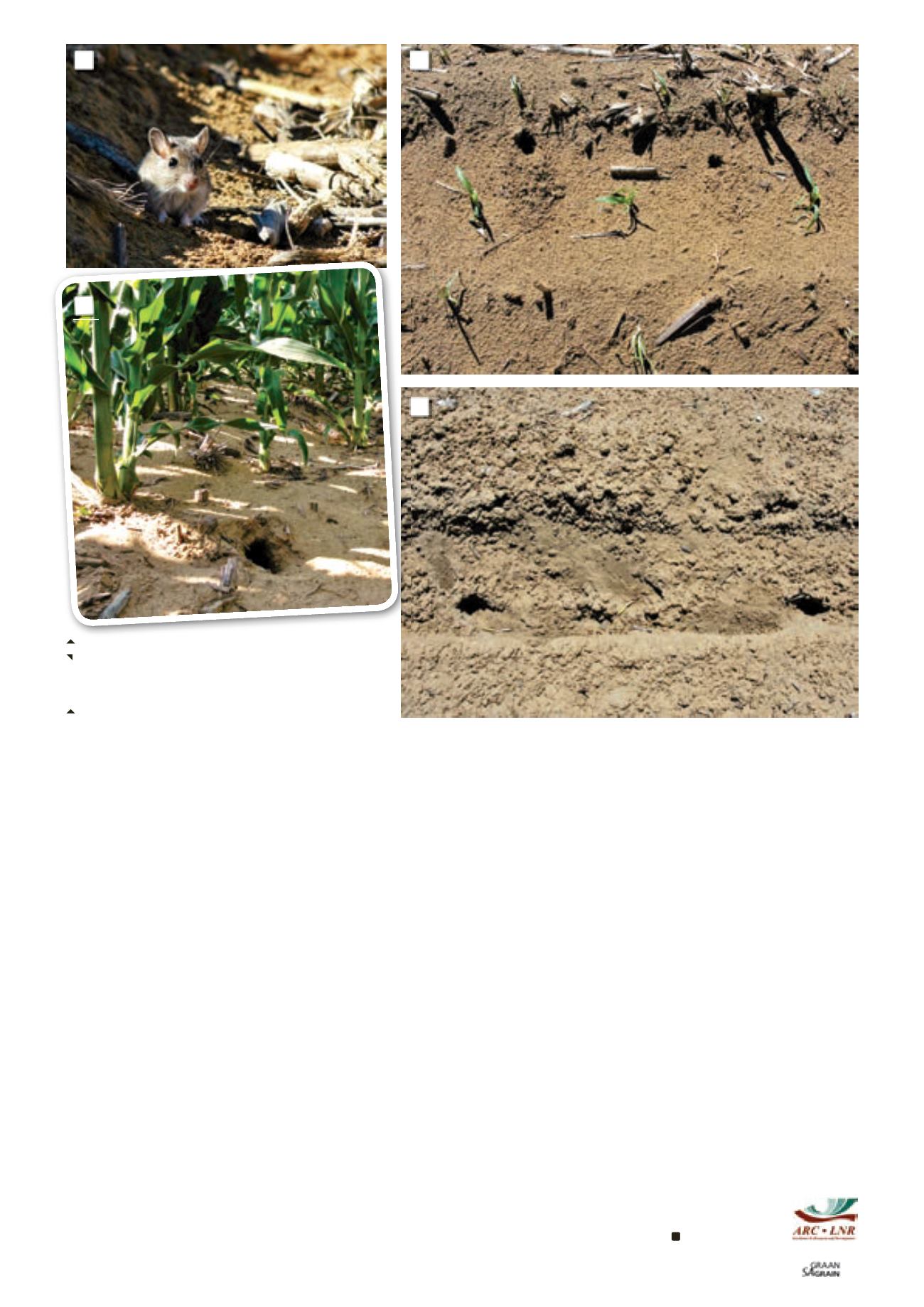
107
October 2014
to seedlings was reduced. Gerbil digging
marks in the soil near treated seedlings
(
Photo 2
) were noted, and the conclusion
was made that a sub-lethal dose caused
aversion towards zinc phosphide treated
seedby survivinggerbils.
Two months after planting, maize plants in
themarkedplots (10mx24m)werecounted
to determine the impact of gerbil colonies
on maize plant density. Zinc phosphide
treatedmaize had an average of 530 plants
per plot, compared to the average of 349
plants in the untreatedplots – a decreaseof
34% inplant density (
Graph 1
).
Although seed treatment with zinc phos-
phide was effective at reducing the im-
pact of gerbil damage onmaize at planting
where itwas tested at sites in theFreeState
Sandveld, itmaynot beas effective inareas
with acidic (lowpH) water or soilmoisture.
Zinc phosphide (Zn
3
P
2
) is used as a
rodenticide because it is claimed that its
pungent, garlic-like odour attracts rodents,
but repulses other animals. Birds are not
sensitive to the smell. The acid in the
digestive system of rodents reacts with
phosphide to generate the toxic phosphine
gas (PH
3
). Zinc phosphide breaks down
when exposed to water or moist soil in the
environment, thus zinc phosphide treated
seed must be planted within 24 hours of
treatment. The use of correct protective
clothingwhenmixing is important.
Information gathered from producers that
terbufos and ammoniac gas may have a
repulsive effect on gerbils, was tested in
trials where these chemicals were used as
part of normal farming practices. In a trial
with zinc phosphide treated seed, planted
together with terbufos (as a soil applied
insecticide/nematicide) and compared to
zinc phosphide treated seed only, the com-
binationdid not add to the effect of the zinc
phosphide treated seedongerbils.
Where ammoniacgaswas used as fertiliser,
the number of burrows in the colonies of
both treated and untreated sites was re-
duced, but differences between the sites
werenot significant.The reduction incolony
sizecanbeattributed to the soil disturbance
during the tillage (rip) processandnot to the
“smell” of the chemical.
Burrow baiting
Burrow baiting trials were conducted in a
maize field during February toMarchwhen
maize was in the vegetative growth stage
and it was presumed that gerbils would be
susceptible to the bait, as there was little
food available on the soil surface (
Photo 3
).
Two different ready-bait (wax block)
rodenticides, namely coumatetralyl and
flocoumafen, and an untreated control,
were applied in 20 m x 20 m plots with
knowngerbil colonies.
Burrows in the plotswere closed, the active
burrows were baited on day 1, the process
repeated a week later (day 7) and the
active burrows counted again after 14 days
(day 21). Both rodenticides reduced the
number of active burrows by more than
70% compared to the untreated control
within the threeweek period (
Graph 2
).
The trials were repeated in the same plots
with the same gerbil colonies during May
when maize was at the pre-harvest stage,
with similar results in the reductionof gerbil
burrows. It must be noted that the gerbil
colonies had recovered tomore or less the
same numbers duringMarch toMay so that
the trial couldbe repeated.
Project trials are ongoing. We thank our
funders; the Maize Trust and the ARC
for their support, as wel as
Grain SA and the producers
in the Sandveld for their co-
operation.
1: TheHighveldgerbil.
2:Maize seedlings of zinc phosphide treated seed com-
pared tountreated seed. (a) Gerbil diggingmarks are visible
near treated seedlings; (b) untreated seedwas removedby
gerbils.
3: Burrowbaiting inmaize.
1
3
2a
2b


